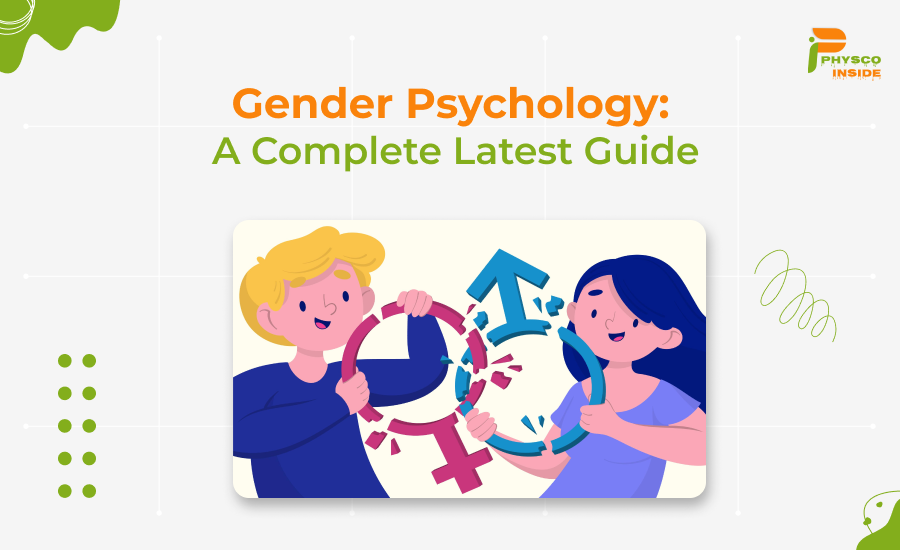(1) Introduction:
Gender Psychology is concerned with how a Person’s Biological sex and Cultural Upbringing shape their mental experiences and behavior. It Explores the problem of gender identity, roles, and Stereotypes. That is how they influence Awareness, emotions, and relationships. By Exploring differences and Similarities between gender Psychology. It helps us to understand human variety and promote gender Equality. This article gives you lots of information about gender roles and Equality. This field draws from Psychology, Sociology, biology, and Humanities to resolve the complex Interplay between biology, culture, and Psychology in shaping our Gender experiences.
(2) Definition of Gender Psychology
“Gender Psychology is the field of Psychology that Examines how Biological sex and Sociocultural factors influence mental development, behavior, and experiences.”
(3) Historical Context/Evolution of Gender Psychology
- Early mental process theories include Freud’s Psychoanalytic theory and the Behaviorist perspective. These Highlights the influence of biology and Socialization in shaping individual attitudes and behavior.
- During the 19th and 20th centuries, the Feminist movement Questioned traditional gender roles and norms. That led to a Re-evaluation of gender and Sexuality in Psychology. This resulted in the Emergence of position studies as a wide field.
- Towards the end of the 20th century, there was a significant shift in how the position was viewed. It was seen as a social setup that was Influenced by Sociocultural factors. It challenges hard twin concepts and recognizes the variety of experiences.
(4) Main Influencing Factors for Gender Psychology:
(4.1)Biological Foundations of Gender
In the study of gender Psychology, the Biological foundations of gender refer to the natural factors. It Contributes to the development of identity, differences, and Similarities between genders.
- Biological Differences Between Genders: Chromosomal, Hormonal, and physical differences among males and females, such as XX and XY Chromosomes, levels of Testosterone and Estrogen, and Reproductive anatomy.
- Hormonal Effects on Behavior and Perception: The role of chemicals, particularly Testosterone and Estrogen. It influences behavior and mental Processes such as Aggression, spatial Abilities, and personal Regulation.
- Brain Structure and Function: Research on differences in brain structure and function between males and females. It includes areas Associated with language processing, spatial Navigation, and personal Cognition.
(4.2)Development of Gender
This development occurs in various stages and is Influenced by different factors, including:
- Early Socialization: Gender Socialization begins early in life as children learn about gender roles and Expectations from family members, friends, media, and other Cultural sources.
- Formation of Gender Identity: Children develop their sense of gender identity. It may range with their Biological sex (Cisgender) or differ from it (Transgender or Non-binary). This process involves Awareness and Identification with Socially defined gender class.
- Internalization of Gender Norms: People Internalize Cultural norms and Expectations Associated with their gender, shaping their beliefs, attitudes, and behaviors. This adaptation process occurs through Reinforcement, Modeling, and Social Comparison.
- Gender Role Development: Children learn and adopt Gender-Typical behaviors, interests, and activities that are set with social Stereotypes Associated with their gender. They may also face pressure to observe traditional gender roles and norms.
- Gender Loyalty: As children mature, they develop a more stable understanding of gender loyalty. Recognizing that gender is Consistent across different situations and Settings.
- Exploration and Flexibility: Some individuals may explore and challenge traditional gender norms. This expresses their gender identity and behavior in ways that ignore Cultural Expectations. This study can lead to greater gender Flexibility and Fluidity.
Gender Psychology aims to understand the Mechanisms underlying this development. It’s a Suggestion for individuals’ mental health and identity Formation.

(4.3)What are Gender Roles and Stereotypes?
(4.3.1) Definition
- Gender roles: These are sets of attitudes, behaviors, and traits. Which society considers Relevant for individuals based on their perceived gender identity. They include Expectations about how people should dress, behave, and Interact with others.
- Gender Stereotypes: These are Deformed and often Incorrect beliefs or Assumptions about the Attributes and Abilities. The behaviors of individuals are based on their gender identity. Stereotypes can be positive or negative but are Typically select and limit individual expression.
(4.3.2) Origins and Perpetuation
- Cultural norms: Gender roles and Stereotypes are often shaped by social, Cultural, and Historical factors. They are passed down through generations and Established by various social Institutions. It includes family, media, education, and religion.
- Socialization: People are Socialized into gender roles and Stereotypes from an early age through Interactions with family members, friends, and media. Support of Gendered behaviors and Expectations begins early in childhood and continues throughout life.
(4.3.3)Challenges and Consequences:
- Limitation: Orientation roles and Stereotypes can be Selective. Limiting individuals’ Opportunities for Self-expression, personal growth, and Fulfillment.
- Inequality: Stereotypical beliefs often Contribute to gender Inequality. To maintain traditional gender roles and Establish power Imbalances between genders.
- Complexity: Gender roles and Stereotypes divide with other social Identities such as race, Nationality, Sexuality, and Economic status. It leads to complex experiences of Favoritism and Marginalization.

(4.4)What are Gender Similarities and differences?
(4.4.1)Gender Similarities
- Mental Abilities: Both sexes present nearly Identical levels of knowledge, memory, and critical thinking Abilities.
- Profound Experiences: People share similar personal ranges, but expressions may differ due to Socialization.
- Basic Mental Processes: Perception, Reflection, and Learning show no significant Gender-Based Variations.
- Character Traits: While distributions are similar, slight differences may exist in Attribute levels.
(4.4.2)Gender Differences
- Behavior: Men tend to be more open to physical Aggression and Risk-taking behavior. While women exhibit more Supporting behavior.
- Communication Styles: Women often engage in Relationship-align communication, Focusing on connections. While men usually use Report-align communication, Spotlight information, and goals.
- Spatial Abilities: Men may perform better than women in tasks Requiring spatial Perception and Navigation.
- Biological Influences: Hormonal variations and differences in brain structure Contribute to some Psychological differences.
(5) How are Gender Psychology & Mental Health Linked?
(5.1) Difference in Sexual Gender and Emotional Health Disorders:
Research has shown that there are differences in mental health issues among various sexual genders. For instance, women are more likely to experience mood Disorders such as Depression and anxiety. Whereas men have higher rates of Externalizing issues like Substance abuse and aggressive behavior.
(5.2) Gender Experiences of Mental Health Issues:
Research has shown that there are differences in mental health issues among various sexual genders. For instance, women are more likely to experience mood Disorders such as Depression and anxiety. Whereas men have higher rates of Externalizing issues like Substance abuse and aggressive behavior.
(5.3) Cultural Assumptions and Gender Roles:
Traditional gender roles and Cultural beliefs can Compound mental health challenges. For example, women may face pressure to balance Caregiving Responsibilities with work, leading to stress and burnout. Men may feel pressure to follow to beliefs of emotional Detachment and Independence, inhibit their ability to seek help.
(5.4) Intersectionality:
Sexual gender divide with other social Identities such as race, Ethnicity, and gender identity, shaping mental health experiences. Various Approaches recognize how multiple Marginalized Identities Interact to influence mental health outcomes and access to resources.
(5.5) Help-Seeking Behaviors and Treatment Variance:
Gender norms may impact Help-Seeking behaviors, with men often being less likely to seek mental health support due to Disgrace and concerns about Masculinity. Addressing Gender-Specific Barriers to treatment is critical to Ensuring fair access to care.
(6) How are Gender and Relationships Interlink?
Read the Following points to easily understand, how gender and Relationships interlink with each other in the field of Gender psychology.
- Gender plays a significant role in how relationships are formed. It impacts dating practices, partner Selection, and overall relationship dynamics.
- Gender differences in communication styles affect how couples resolve Disagreements and express emotions.
- Nurturing practices, division of family Responsibilities, and family dynamics are also shaped by gender roles.
- Friendships and social networks are Influenced by one’s gender and can impact the Formation of social support systems.
- Cultural Expectations and gender standards also shape attitudes toward Attachment, sexual expression, and relationship Satisfaction.
- Understanding how gender crosses with other social Identities can provide insight into the various experiences within relationships.

(7) Role of Gender Sexuality in Gender Psychology:
- Gender identity and sexual gender: Gender Psychology Examines how a Person’s gender identity (their sense of being male, female, or another gender) Intersects with their sexual gender (Attraction to others based on gender).
- Gender expression and sexual identity: The field also studies how individuals express their sexual gender Publicly. Also, how this connects with their gender identity, including labels such as lesbian, gay, Bisexual, or queer.
- Intersectionality and Social Identities: Gender and Sexuality Intersect with other social Identities, such as race and Ethnicity, shaping experiences of difference, Affirmation, and Belonging.
- Sexual Minority Stress and Mental Health: LGBTQ+ people often experience differences and stigma. It can contribute to mental health challenges. Therefore, it’s essential to provide Supportive environments and Inclusive Policies.
- Fluidity and Diversity: Gender and Sexuality are fluid and diverse, Evolving for individuals. It highlights the need for Embracing, Accepting, and Affirming diverse Identities.
(8) Gender Psychology Role in Society and Culture:
- Gender Psychology studies how Cultural and social factors shape beliefs, values, and behaviors related to sexual gender.
- Society imposes Expectations and roles on individuals based on their perceived gender. It impacts everything from personal identity to social relationships.
- Social practices, traditions, and Institutions support gender norms and maintain Inequalities and differences.
- Gender plays a significant role in various domains of society, including education, Employment, politics, and Interpersonal dynamics.
- Understanding the complex Compromises between gender and society. It is important for Addressing structural Injustices, Promoting gender Equality, and creating overall environments. Where individuals can succeed regardless of their gender identity or expression.
(9)Future Directions/Challenges in Gender Psychology
Future Directions and Challenges in Gender Psychology can be Explored in various areas to better understand various experiences Comprehensively. These areas include:
- Intersectionality and Diversity: Gender crosses with other social Identities, such as race, Ethnicity, Sexuality, and religion. Exploring these crossings can help us understand how various individuals experience gender.
- Gender Fluidity and Non-Binary Identities: It’s important to investigate the experiences and needs of individuals with Non-binary and Genderqueer Identities to challenge binary notions of gender.
- Global Perspectives: Gender psychology should be Examined from global and Cross-Cultural perspectives to Acknowledge Cultural Variations in gender norms and experiences.
- Technology and Social Media: Investigating the role of Technology and social media in shaping gender norms, Identities, and relationships. It can help us to understand their impact on gender Socialization and Activism.
- Mental Health: Addressing Imbalance in Mental Health Outcomes and Developing Gender-Sensitive Interventions can promote Holistic Health.
- Gender Equity and Social Justice: Advocating for gender equity and social justice by Challenging Systemic Inequalities and Promoting overall Policies and Practices. This across various domains can help promote a more just and fair society.
(10) Tips to Improve Gender Psychology (5 Tips)
(10.1) Educate Yourself:
Take Creativity to learn about Gender-related issues, including gender identity, careers, stereotypes, and Variations. Read books, articles, and research papers on the topic, and seek out diverse Viewpoints and voices.
(10.2) Listen and Learn from Others:
Engage in conversations with people from different gender Identities and backgrounds. Listen Actively to their experiences, perspectives, and challenges related to Orientation. Be open to learning from their Insights and lived experiences.
(10.3) Challenge gender Stereotypes:
Question traditional Orientation norms and Stereotypes that you Encounter in daily life. Challenge beliefs and biases about what is considered “normal” or “appropriate” based on Orientation. Encourage others to do the same.
(10.4) Promote Inclusivity and Equity:
Support for gender Equality in all aspects of life, including education, Workplace policies, media representation, and community initiatives. Support efforts to create conditions where people of all genders feel valued, Respected, and Empowered.
(10.5) Be an Ally:
Take action to support and uplift people who face differences based on gender. Use your influence and benefit to increase their voices, Advocate for their rights, and create positive change.
(11)Conclusion
In summary, the study of gender Psychology provides valuable Insights into the Complexities of sexual gender, roles, and dynamics. By understanding the Interaction of biological, societal, and cultural factors, we can address gender biases and challenge stereotypes. It promotes Inclusivity and Equality. Through education, Approval, and empathy, we can work towards creating a world where individuals are free to express their thoughts openly. Somewhere, sexual gender Diversity is celebrated and respected.
Frequently Asked Questions (FAQS)
Gender psychology is the study of how gender affects behavior, perception, and emotions. It explores topics such as gender identity, roles, stereotypes, and biases.
Biological factors, socialization, culture, and individual experiences contribute to the formation of gender identity.
Orientation roles shape cultural expectations about how individuals should behave based on their perceived gender. It affects behavior, attitudes, and social relationships.
Sex refers to biological differences such as anatomy and physiology. While gender refers to social and cultural forms related to identity, roles, and expressions.
Gender psychology sheds light on efforts to challenge stereotypes and promote gender equality. It creates overall environments that respect and value people of all ages.
Variety recognizes how gender divides with other social identities, such as race, nationality, and sexuality, shaping individuals’ experiences and challenges in unique ways.


